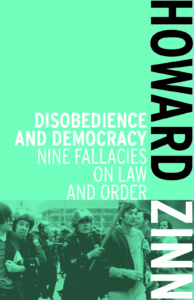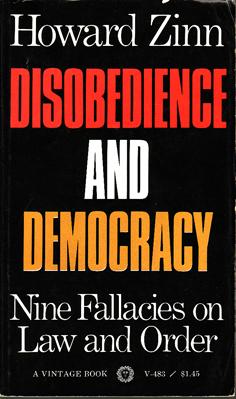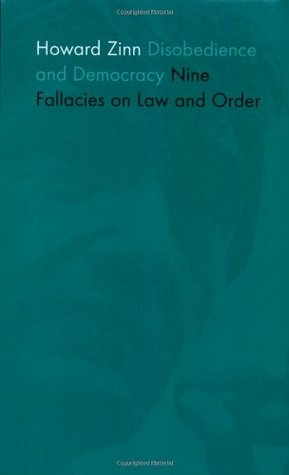 Disobedience and Democracy: Nine Fallacies on Law and Order — In this slim volume, Zinn lays out a clear and dynamic case for civil disobedience and protest, and challenges the dominant arguments against forms of protest that challenge the status quo. Zinn explores the politics of direct action, nonviolent civil disobedience, and strikes, and draws lessons for today. [Publisher’s description.]
Disobedience and Democracy: Nine Fallacies on Law and Order — In this slim volume, Zinn lays out a clear and dynamic case for civil disobedience and protest, and challenges the dominant arguments against forms of protest that challenge the status quo. Zinn explores the politics of direct action, nonviolent civil disobedience, and strikes, and draws lessons for today. [Publisher’s description.]
Published by Vintage and Random House, 1968; South End Press, 2002; Haymarket Books, 2013.
Previous Editions


Table of Contents
- Introduction
- First Fallacy: that the rule of law has an intrinsic value apart from moral ends. (By “moral ends” I mean the needs of human beings, not the mores of our culture.)
- Second Fallacy: the person who commits civil disobedience must accept his punishment as right.
- Third Fallacy: that civil disobedience must be limited to laws which are themselves wrong.
- Fourth Fallacy: that civil disobedience must be absolutely nonviolent.
- Fifth Fallacy: that the political structures and procedures in the United States are adequate as they stand to remedy the ills of our society.
- Sixth Fallacy: that we can depend on the courts, especially, the Supreme Court, to protect our rights to free expression under the First Amendment.
- Seventh Fallacy: that our principles for behavior in civil disobedience are to be applied to individuals, but not to nations; to private parties in the United States, but not to the United States in the world.
- Eighth Fallacy: that whatever changes are taking place in the world, they do no require a departure from the traditional role of the Supreme Court playing its modest role as a “balancer” of interest between state and citizen.
- Ninth Fallacy: that we, the citizenry, should behave as if we are the state and our interests are the same.
Preface to the South End Press Edition
By Howard Zinn
Among the first Americans to commit acts of civil disobedience in protest against the war in Vietnam were young Black civil rights workers in the South. In the summer of 1966, six members of the Student Nonviolent Coordinating Committee (SNCC) were arrested for invading an induction center in Atlanta. The American intervention in Vietnam had escalated dramatically in the spring of 1965, and almost immediately there were mass refusals to be inducted in the military. By mid-1968, there were more than three thousand prosecutions of such resisters. The burning of draft cards by young men, the invasion of draft boards by religious pacifists, became rituals of the anti-war movement. When David O’Brien burned his draft card on the steps of the courthouse in South Boston, he was prosecuted, and the Supreme Court, by a vote of 7-1, upheld his conviction, rejecting his claim that it was an act of free speech protected by the Constitution. When Abe Fortas, one of those justices condemning David O’Brien, wrote a booklet on civil disobedience, justifying such prosecutions, I decided to write a response. The result was this little book, which sold over 70,000 copies and served as a theoretical buttress to the many acts of civil disobedience committed during those years of the war in Vietnam. In the decades that followed the end of the war, many more acts of civil disobedience continued, to protest the militarization of the country and the production of weapons of mass destruction. In the prosecutions that followed, I was called on many times to testify on behalf of the defendants, and drew repeatedly on the arguments contained in this book.



